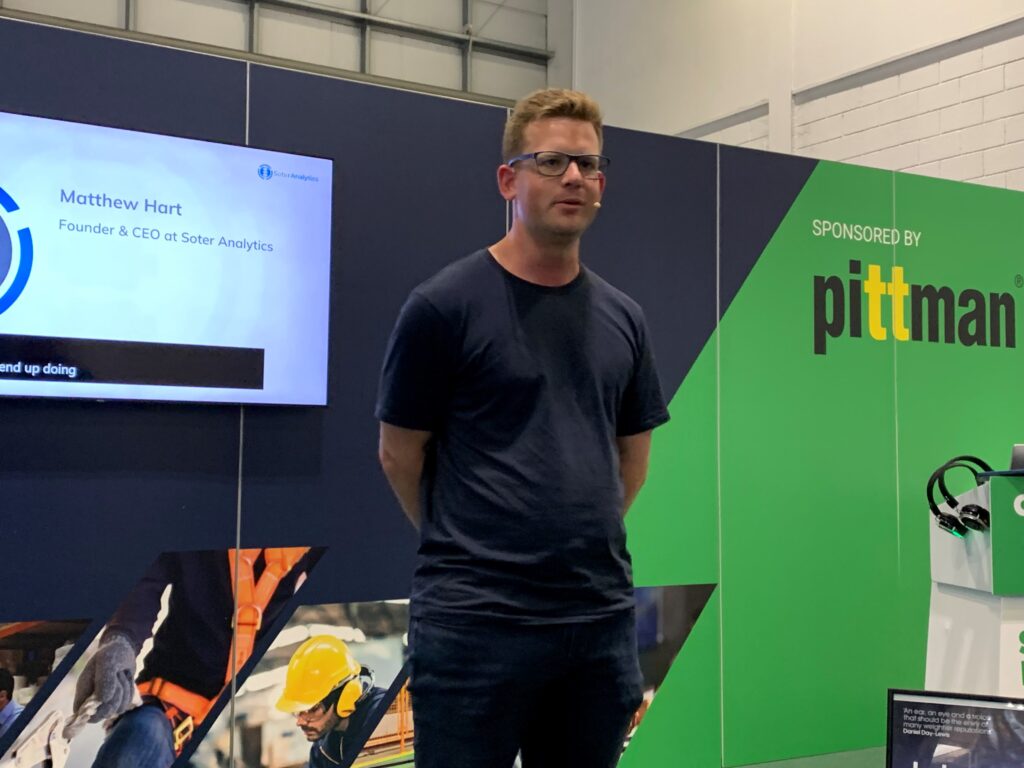Training employees about safety in ergonomics and movement can be challenging, even before considering the turnover rate. Participating in a course, having onsite reviews or regular check-ins can help, but much like ‘teaching a man to fish,’ how can proper behaviour and activity become normalised?
One option is the use of safety wearables, which are designed for ergonomic safety and measure hazardous movements of the spine or shoulder. This involves the integrated use of ‘haptic’—or touch—feedback, based on the concept of negative reinforcement. When a certain behaviour or action leads to a negative stimulus, the subject is less likely to behave that way in the future.
Matthew Hart, founder and CEO at Soter Analytics, spoke to the development of such sensors and how they positively benefit workplace safety in his presentation at Safety & Health Expo. Here, we look at key highlights from his presentation.

Matthew Hart, CEO, Soter Analytics
Hart’s inspiration came from his background as a reliability engineer working in mining. By looking at historic data, the team could assess more effectively when machines needed to be serviced or have parts changed. But when sensors were added into the mix, the live data could inform when to make repairs or replacements, extending the life of the machines and improving efficiencies. What if a similar approach could be put into play with humans—avoiding injuries by changing behavior?
Soter developed wearables designed to give feedback to employees in real time. “By giving the right data to the right person to make the right decision, they can solve the problem themselves,” Hart said. The sensors can be worn on the back of the shirt or arm, and are being integrated into helmets. While it’s worn, it collects live data; using an algorithm, it assesses whether a movement could cause harm, and alerts the wearer with a beep or vibration.
This physical reminder of a high-risk movement changes the way the person behaves, and further embeds the change. Hart said generally after two to four weeks, the changes are integrated into action. That said, success only comes when the wearables are worn, making an integrated roll-out and communication strategy key to success.
“You must engage multiple stakeholders, management must understand the purpose, and training must be integrated to help uptake and ongoing use,” Hart said. Further, he encouraged companies that integrate wearables into a safety management program to emphasize the objectives—this is to make the workplace safer and the team more productive. He added, “We work very closely with our partners to make sure that this data is never used for negative performance management,” adding that they can also anonymize the data, giving added confidence to employees.
One success study Hart shared was working with a major, international clothing retailer in the warehouse, where the company saw an 87% reduction in injuries in the first year integrating the technology. They found that by de-risking the process, the workforce became more engaged, and reports of musculoskeletal injuries plummeted. Further, the feedback and data allowed the organization to design new solutions and processes, which empowered the workforce further. Soter is in the third year of the partnership, which has had an added benefit, Hart noted, as the workforce has also become more gender diverse and turnover rates have declined significantly. “We’re enabling more people to do more work and making that work easier,” he said.
Approaches to managing the risks associated Musculoskeletal disorders
In this episode of the Safety & Health Podcast, we hear from Matt Birtles, Principal Ergonomics Consultant at HSE’s Science and Research Centre, about the different approaches to managing the risks associated with Musculoskeletal disorders.
Matt, an ergonomics and human factors expert, shares his thoughts on why MSDs are important, the various prevalent rates across the UK, what you can do within your own organisation and the Risk Management process surrounding MSD’s.


